The Huawei P8 Review
by Andrei Frumusanu on June 4, 2015 8:00 AM EST- Posted in
- Smartphones
- Huawei
- Mobile
- P8
- Kirin 930
Camera Architecture
Huawei spent a lot of time to talk about the P8's camera as it probably represents the single biggest upgrade over past models. Huawei only recently experimented with an exotic dual-camera system in the form of the Honor 6 Plus, but such a system still brings some disadvantages with it, such as the impossibility to have any kind of optical image stabilization.
The P8 goes back to a more traditional single-camera system, but Huawei opted to integrate a new innovative RGBW sensor coupled with a performant OIS implementation for its new camera module.
We already had experience with non-Bayer (RGBG or RGGB) image sensors in the form of OmniVision's OV10820 sensor in the original Motorola Moto X. So while it's technically true that the P8 sports the first 13MP RGBW sensor, it's not the first RGBW sensor out there.
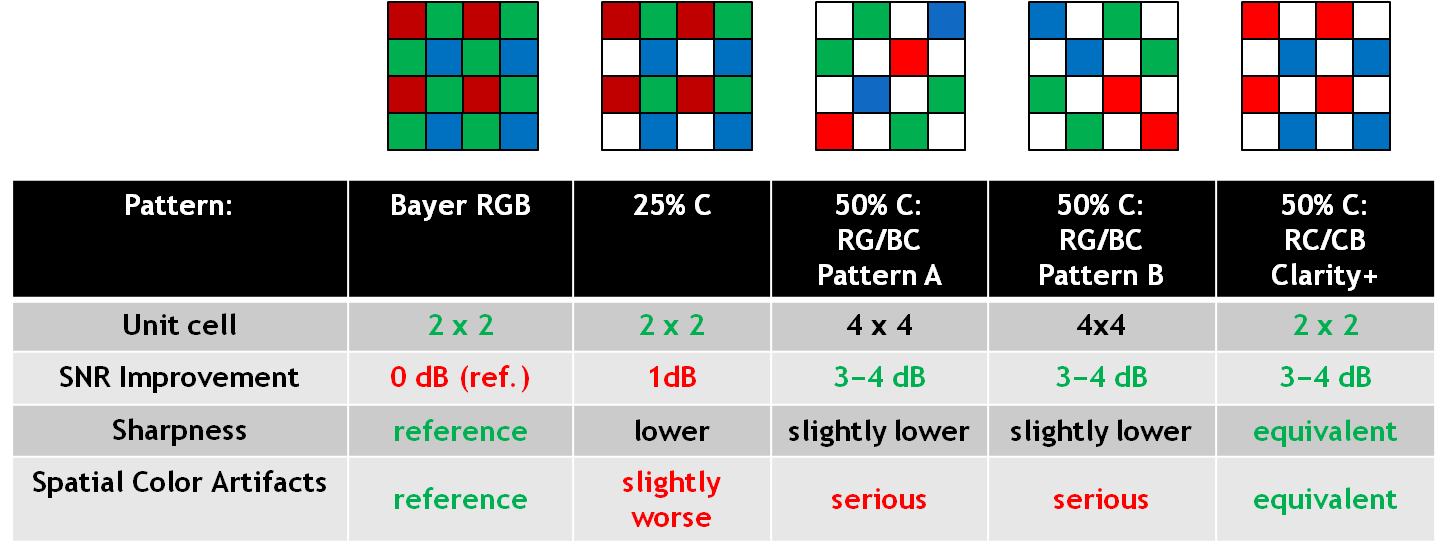
Source: Aptina
RGBW or also sometimes referred to as RGBC (C for clear) sensors are supposed to be able to increase the sensitivity of the image sensor by repurpusing one of the green sub-pixels of the normal Bayer arrangement with a white/clear one that is more sensitive to luminance than the conventional coloured sub-pixels.
The sensor in the P8 is provided by Sony in the form of the IMX278. We don't have any public information on this piece as Sony hasn't officially announced it yet, but Chipworks has a very recent teardown in which they confirm 1.12µm pixel size and DTI (Deep Trench Isolation). DTI has by now become standard in high-end sensors and both the IMX214 and IMX240 also feature it. Most famously SLSI markets the technology as Isocell in its camera sensors and have seen its use in the S5K2P2 sensor of the S5 and S6.
Sony had previously tried to make an RGBW sensor before in the form of the original IMX135, but the piece was later on downgraded to a traditional Bayer sensor before it was launched in devices such as the Galaxy S4.
The OmniVision sensor of the Moto X suffered from severe colour artifacts and this led to some loss of confidence in the technology as this seemed an inevitable side-effect of the sub-pixel layout. Luckily in my time with the P8 I haven't noticed any such issues, and the IMX278 seems to perform very well in low-light conditions.
The Kirin 920's build-in ISP performance in the Mate 7 and Honor 6 was another huge weak-point that Huawei has since addressed. The Honor 6 Plus already re-introduced an external ISP by Altek, and the P8 again includes a similar Altek AL6010 chipset.
Finally, Huawei claims that its OIS implementation is superior with 1.2° angle of movement, but this isn't as much as an advantage over other devices than it is over the iPhone 6 Plus. LG's G4 camera system now for example offers a 3-axis OIS implementation with up to 2° freedom of movement, making it the current holder for the title of best-in-class OIS system.
On the lens system, Huawei keeps the camera's aperture to F/2.0 as in the Mate 7/Honor6. The 35mm effective focal length slightly rises to 29mm, making the P8's field-of-view a tiny bit narrower than previous models.
On the front-camera, Huawei now uses a larger 8MP Sony IMX179 sensor with 1.4µm pixel pitch with F/2.4 aperture and 26mm equivalent wide angle lens.
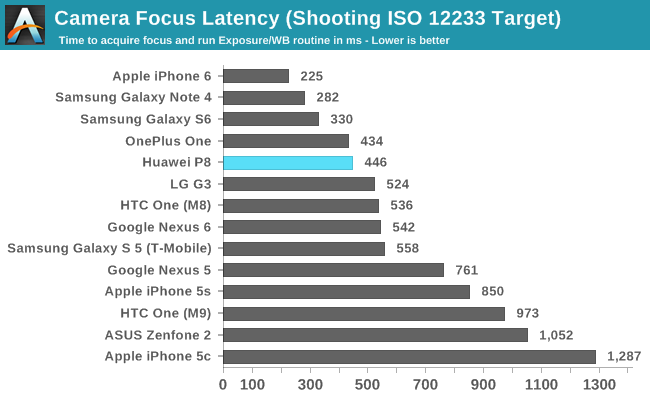
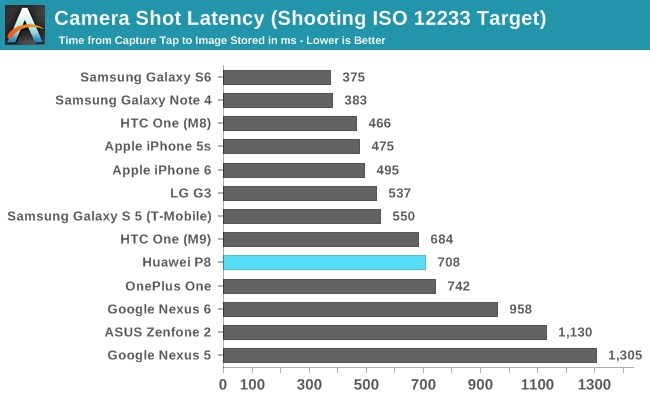
Capture latency is average, as it takes a focused target about 708ms from the moment the tap for capture is registered to having the image stored. In everyday usage, the P8 performs well in terms of capture speed and doesn't have any outstanding issues in that regard.
Camera UX
The camera interface of the P8 largely carries over what we've seen on the Mate 7. The basic viewfinder is minimalistic and keeps elements to a minimum. Swiping left/right, or up/down when in horizontal mode will change the capture mode between standard Photo, Beauty or Light-painting mode for still-picture capture, and basic Video and Time-Lapse modes for video capturing.
Huawei exposes the same limited camera controls as on the Mate 7 - meaning a choice of ISO, white balance and further slides that adjust exposure, saturation, contrast and overall brightness. Sadly these options are not true camera adjustment knobs as they don't expose any actual values to the user. Their location deep in the settings menus also make them unusable in every-day operation.
The settings menu option are contextualized depending on the current shooting mode, and it will remember the settings of that particular mode. And interesting option here is the ability to turn on and off OIS for still picture capture. Normally this doesn't make any sense as you would never want to really turn OIS off, but it gives us a rare opportunity to see the impact of OIS on image quality as we'll later see in the still image analysis.
Overall Huawei's camera interface seems outdated - this would have been a nice UX 2 years ago, but since then other vendors have continually raised the bar, as seen in LG's G4 or Samsung's Galaxy S6. It is a pity because the P8's camera hardware would definitely deserve a software worthy enough to take full advantage of its capabilities.
Video Performance
Again going back to the video performance of the Mate 7 and Honor 6, Huawei presented one of the worst video quality available at the time. This was undoubtedly due to limitations of the SoC's internal ISP, especially aggravated in HDR and EIS modes.
The P8 manages to improve immensely in video capture quality in all modes as long as you don't enable the EIS mechanism:
1080p30 - No stabilization
1080p30 - Optical image stabilization
1080p30 - Optical + electrical image stabilization
Note 4 reference: [ 1080p30 , 1080p30+EIS , 1080p60 , 1080p60+HDR ]
Mate 7 reference: [ 1080p30 , 1080p30+EIS ]
The image quality when not enabling EIS is good but seems to be severely limited by the native encoding of the video files, as it caps out at 9566Kbps on a AVC Baseline L4.0 codec. Audio is recorded at stereo 96Kbps 16bit 48KHz in an AAC encoding. As with previous Huawei devices, the audio quality is excellent and among one of the best devices in terms of clarity.
As mentioned in the UX section, Huawei allows one to disable OIS in the settings for video recording. This might be useful for niche users who would like to do their on software stabilization: the stock OIS still has issues with image yaw, as we see the 2-axis gyro doesn't perform too well in that regard. For practical uses, one would never want to disable OIS as the improvement to the non-stabilized image is clearly evident.
Enabling EIS on top of OIS makes it possible to alleviate the image yaw, but the cost in image quality is too drastic. Here we see again the same drop in image resolution as presented in the Mate 7: the SoC's ISP reserves itself margins on the border of the video stream for EIS compensation, with the resulting video frame no longer being the full resolution that the sensor captured, but a badly upscaled and processed version of the video frame from the ISP. One loses not only a lof of detail due to the upscaling, but also the field of view is narrower. In general I don't see why anybody would ever want to use the EIS (Labelled as "Stabilizer" in the options) mechanism when a phone has OIS at hand.
Another missing feature that is in need of mentioning is the lack of any 4K recording capabilities. It seems that technical difficulties caused by the raw amount of data captured by a camera's sensor makes 4K video still a super-premium feature that has yet to hit the mainstream devices.


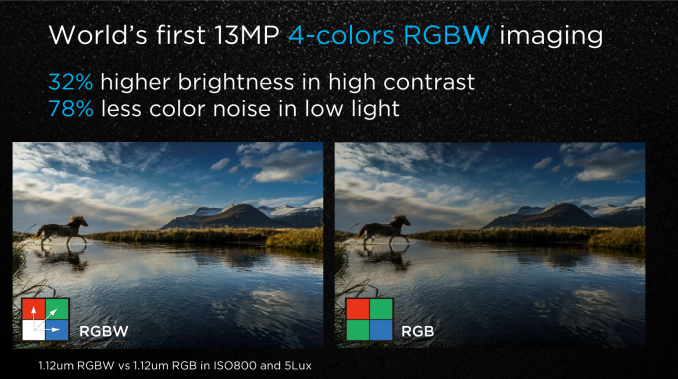
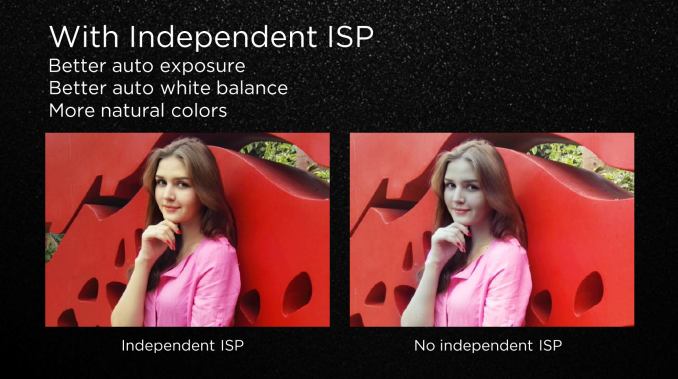
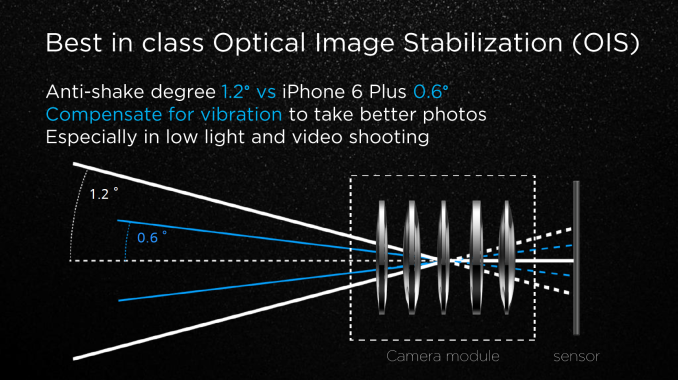
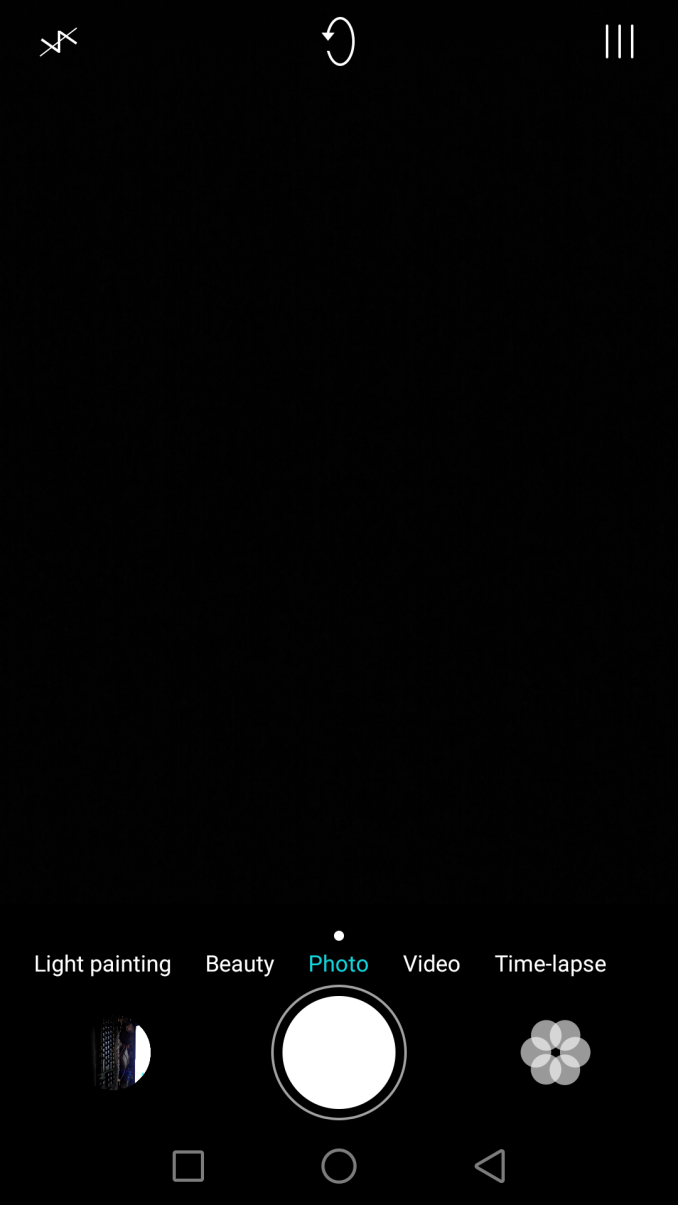

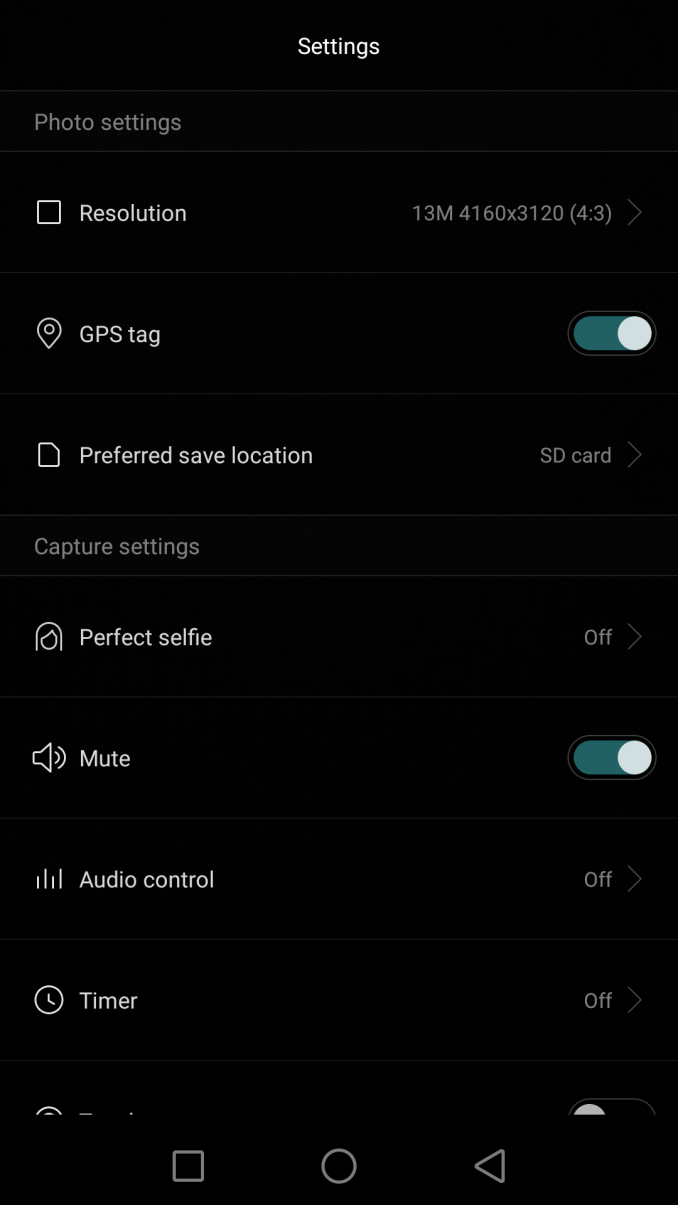
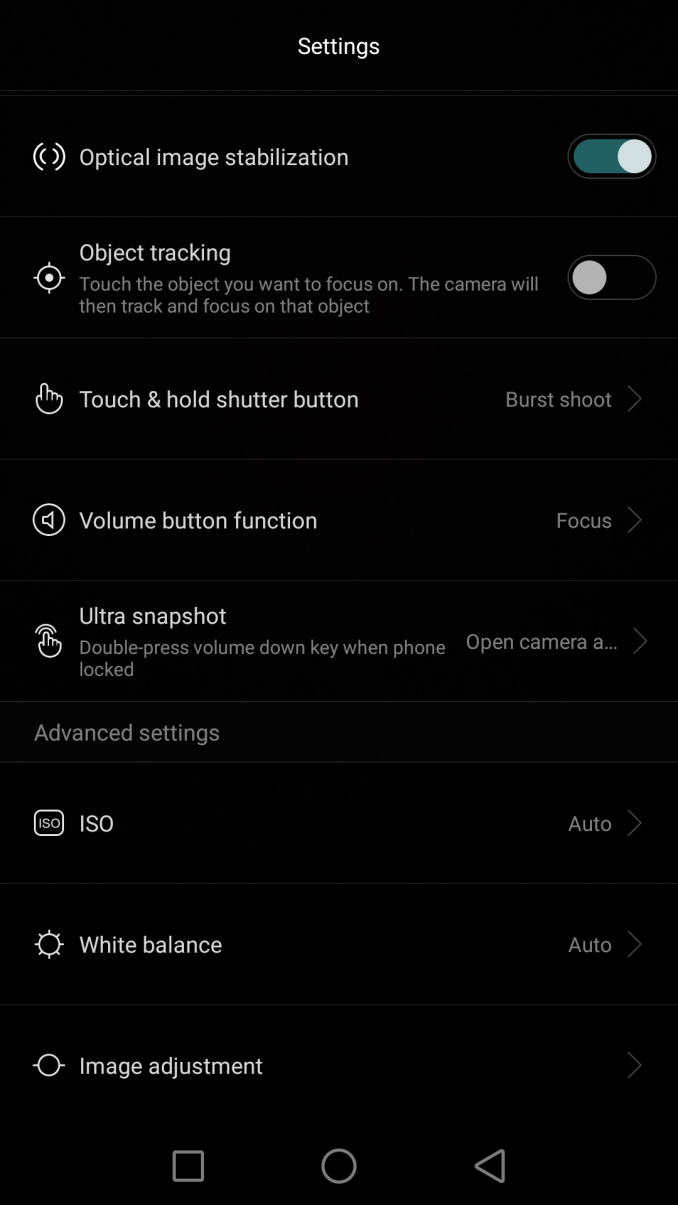
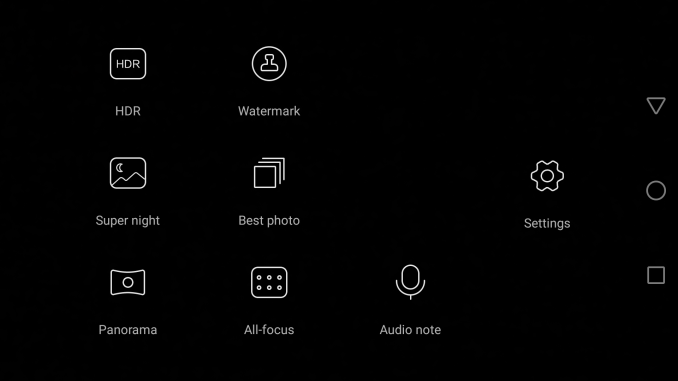








104 Comments
View All Comments
hrrmph - Thursday, June 4, 2015 - link
It's probably more useful than an iPhone for people who travel a lot and occasionally go off the grid, and thus need the device to still work as a GPS, camera, miniature computer, etc, while drawing all data from fast, convenient local storage...- It has a MicroSDXC slot, so it can take the new 200GB MicroSD storage cards; and
- It has dual SIMS.
Unfortunately, it lacks a user removable battery, so it is still inferior in that regard to each of the phones and phablets that I already have. But, in general, I like what they are doing.
Something that other nationals can tend to forget is that China has a lot of wealthy people (far more than the US or possibly even Europe). Even though these elite Chinese are wealthy, many of them are shrewd spenders. They want value for their high-end spend. So there is a lot of pressure on Chinese vendors to produce high-end devices that include every possible feature.
So just like Japanese enthusiasts used to get certain stereos and cameras that America only dreamed of, the Chinese are demanding that the manufacturers provide more fully functional high-end phones that can do everything... including the things that the iPhone cannot do.
That said, the iPhone is making headway in China too...
... but just like in the US, it's for all the wrong reasons. Namely, it's a jewelry piece that holds sway as a status symbol amongst the more vacuous of minds. Owning one supposedly elevates your perceived social status - much in the way that owning a ludicrously expensive sports car or ultra-luxury car does the same (think Rolls-Royce, Bentley, etc.).
Sociologists and psychologists have hypothesized that such objects are attractive to both the buyers who display them publicly and to those who view them, particularly the opposite sex.
People who buy these objects are subliminally advertising to potential mates that they have excess money that (under the proper circumstances) can in the future be re-directed to caring and tending for children and non-working spouses.
The attraction effect is generally stronger if the object is purchased and displayed by a male, because many societies still expect the male to bear the larger burden of providing financial resources. This is especially the case while the female is pregnant and in the early years of caring for children that aren't yet school aged.
The larger the excess spend over the practical value, the higher the perception of excess earning capacity. That's why we sometimes see phones sold with precious jewels encrusting them. Apple is just doing the same thing on a lower level... right out of the box. Charging more than the inherent underlying value.
So it's rather refreshing to see the Chinese manufacturers taking a different approach.
And it is especially refreshing to see the Chinese doing this in light of the fact that Samsung vacated the market as an Apple competitor and have now lowered themselves to merely matching Apple's product features. Without the Chinese, the Apple-Samsung twins (newly conjoined) don't really have any competition. The Chinese upping their game changes things.
Of course Apple can play this game too if they want. They simply need to offer more than 264GB of storage. The P8's 64GB of onboard NAND storage combined with the new SanDisk 200GB Micro-SDXC storage card will now set a very high bar that Apple needs to try to hurdle over (if Apple wants to be taken seriously with regard to storage).
I'm thinking that if Apple offers its next phone with 512GB of storage then that would safely secure the storage crown for them (remember, Samsung used to regularly double Apple's storage by simply adding a Micro-SD slot, but Samsung has now given up on competing).
Then Apple would need to add Dual-SIM slots to improve connectivity and travelability. It may come as a surprise to the uninformed that the newly wealthy Chinese (like many other nationals) are joining the tourist-corps. They are world travelers and they want their phones to work anywhere that they are likely to travel. Having Dual-SIMs makes it both convenient and affordable (roaming data charges are still the bane of the planet, even for wealthy Chinese).
I would also argue that to be better than what I've personally already got (and most Chinese, other Asians, Middle-Easterners, Africans, and Europeans already have), Apple would need to offer user removable back covers and batteries. Nothing says "I can handle a thirty hour multiple segment, multi-modal (air, sea, and land) journey" than a couple of lightweight fully-charged spare batteries. No awkward cables... just plop in and play on like nobody's watching.
So the Chinese phones are Apple clones? Nahh, this is just the Chinese practicing for the end-game. They want to do what Samsung used to regularly do to Apple: offer the consumer more for less... and the Chinese have just proven that they can win the storage crown. So who is to say they won't eventually win the various other races to provide the best-of-the-best on the other features? All it requires is Apple-Sung to remain lazy… which is something they have lately proven to be very adept at.
pityko - Thursday, June 4, 2015 - link
I signed up just to be able to thank you for this comment. You brilliantly summarised everything that's wrong with the current "leaders" of the mobile phone industry. I've been a Samsung user for years after being disappointed by the iPhone 3G then HTC in general but now when my contract expires for my Note 3 I am leaving for a Chinese brand, I want to support a company that hasn't given up trying.pgari - Thursday, June 4, 2015 - link
Always surprises me how people in these blogs write about what Apple "should do", but for what? To be even more successful? What are their credentials?Of course, anyone can say what they like or dislike. But the implicit assumption in most of these comments is "I know better", which is, at the least, presumptuous
Rod_Serling_Lives - Friday, June 5, 2015 - link
Well said. Apple already dominates with only a handful of devices and I don't know if they could be in a better position than they are currently.nathanddrews - Friday, June 5, 2015 - link
Personally, I don't like anything about Apple except the build quality of most of its products and its stock price. Cha-ching! I don't buy Apple products or use Apple software, but I'm happy the corporation is so successful. Deep down inside, I find myself horribly judging and mocking consumers of Apple products, but then I just have to remind myself not to feel bad about it. They're already dead inside.;-)
Brakken - Friday, June 5, 2015 - link
I think it's Tall Poppy syndrome... even ignoring everything else Apple has pioneered over the years and just looking at the Apple Watch - first gen of hardware and software, and it's amazingly smooth and will have years of support and development. With the hardware makers for Android, they are all dropping support for SD cards and removable batteries, except LG (?), but no one seems to talk about it when it happens. I think people start making 'I know better' statements because they don't check history.MarcSP - Saturday, June 6, 2015 - link
I agree with many of the things you said, but your theory about iphone as a status symbol is incomplete. I mean, according to what you said it seems that most buyers should be single men, and I have seen as many women as men with iPhone in Shanghai (maybe more, as female tend to follow fashion very strongly, and most cannot choose a phone based on "tech" or "features").Also, many married couples and middle aged and old persons use iPhone. Even students have them.
It always strikes me, because in China iPhone's price is quite higher than the average salary in the first tier cities. Imagine if an iPhone cost 2000 USD in the US. Nobody would buy it, but in china they do.
I guess mostly because the "status symbol" thing, but not to impress potential sexual partners, just to say "hey, look, I am NOT POOR", even if you are and cannot afford a health insurance and use recycled oil for cooking. After the communist times, Chinese socity has gone to the other extreme. Now being poor is not just pityful, it is shameful. No matter how, even if you have to sell tainted milk to babies or steal from your fellow citizens with lies, you MUST become rich. Of course, most cannot, so that's why they think having a "symbol" is better than nothing. "Appearence" is king nowadays in China, not "substance". I guess they need 20 more years to find a balance. Too many changes, too fast.
Ethos Evoss - Friday, June 12, 2015 - link
jesu su writing a book ?jjj - Thursday, June 4, 2015 - link
You wish the iphone had a sane design like this instead of their roadkill look.puremind - Thursday, June 4, 2015 - link
If Apple had cloned this device, it would have been better. Instead of the huge bezels it would have had a much more usable form factor.